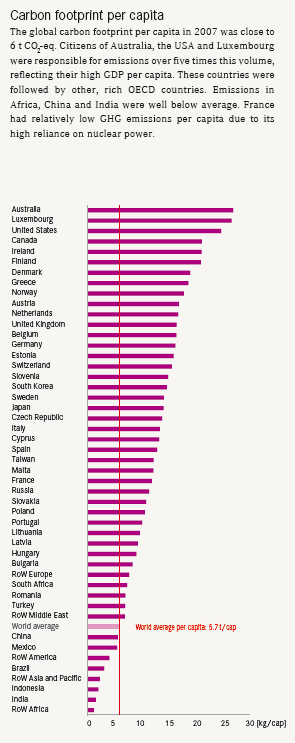The world counts carbon emissions by country where fuels are combusted, i.e. where the CO2 is emitted. A new study shows how great the differences are when we count products consumed. Craig Morris takes a closer look at how Germany, the UK, Russia, China and France fared in the study.
Carbon leakage and carbon shifting are two terms that essentially indicate a situation in which carbon emissions move from one country to another. The outcome can be desired; under emissions trading platforms, countries and market players are encouraged to shift their emissions to where avoidance is less expensive. But the terms are frequently used to show a shortcoming in the way we count carbon emissions: China, for instance, is increasing its emissions largely because it makes products consumed in affluent countries. If they did not consume so much, the argument goes, China would not emit so much.
So who is responsible for what part of whose emissions? I’m not going to try to answer that question for you today, but merely point out the new CREEA study on “The global resource footprint of nations” (PDF), which allows us to show what a difference the two calculations make.

Source: CREEA
We would expect affluent countries like Germany, the UK and France to have considerably larger carbon footprints if we include leakage/shifting. On the other hand, a country’s trade balance matters, and Germany is the world’s largest exporter in terms of its size; furthermore, as readers of this blog know, foreign demand for German power directly increases Germany’s carbon emissions (also see our study German Coal Conundrum). Countries that have undergone some degree of deindustrialization, such as the UK, could be expected to have greater carbon leakage.
Perhaps for political reasons, the study clearly tries not to make it easy for readers to do what I aim to do here: compare countries. The only list of carbon emissions by country per capita is the fairly unreadable one below containing no raw data – all of which is, however, available in the study if you want to fill in the blanks. To facilitate the comparison with carbon emissions per capita without leakage, I will simply use this list from Wikipedia.
In CREEA’s study, France comes in just ahead of Russia including leakage, whereas Germany is two spaces behind the UK. The ranking of those four countries excluding leakage looks quite different, however.
Carbon emissions by selected countries (t per capita, with increase from leakage indicated):
| Including leakage, [difference] | Excluding leakage |
|
|
|
|
|
|
|
|
|
|
The most salient difference is clearly China, whose carbon emissions are lower when leakage is included. Russia also has almost no carbon leakage. France and the UK have carbon leakage nearly as large as their domestic carbon emissions, and while Germany’s leakage is slightly lower relative to its domestic emissions, it still shifts more carbon abroad than France does.
If we take carbon emissions and climate change seriously, more attention should be paid to carbon leakage. I see two potential benefits: we could focus on curbing product consumption; and we have more justification to provide developing countries with greater leeway in curbing their emissions. After all, the location of carbon emissions does not matter in terms of long-term global climate change.
Craig Morris (@PPchef) is the lead author of German Energy Transition. He directs Petite Planète and writes every workday for Renewables International.
